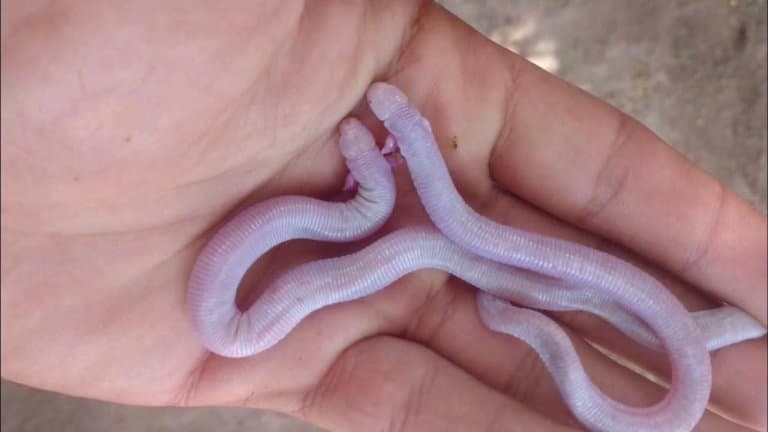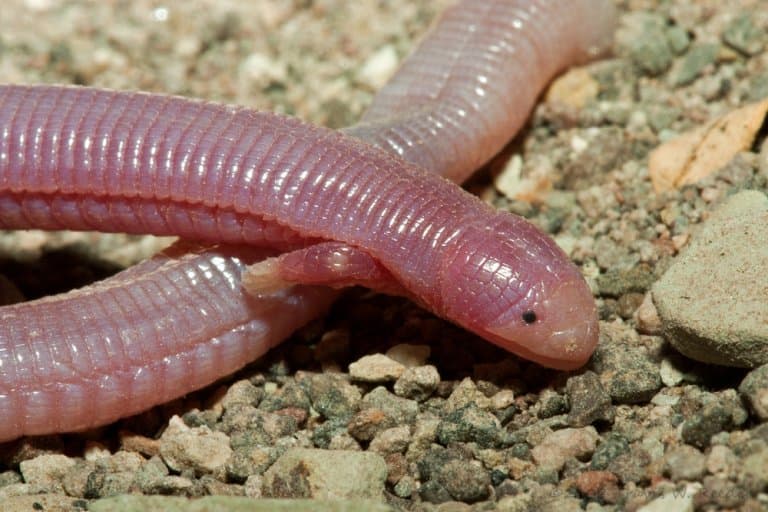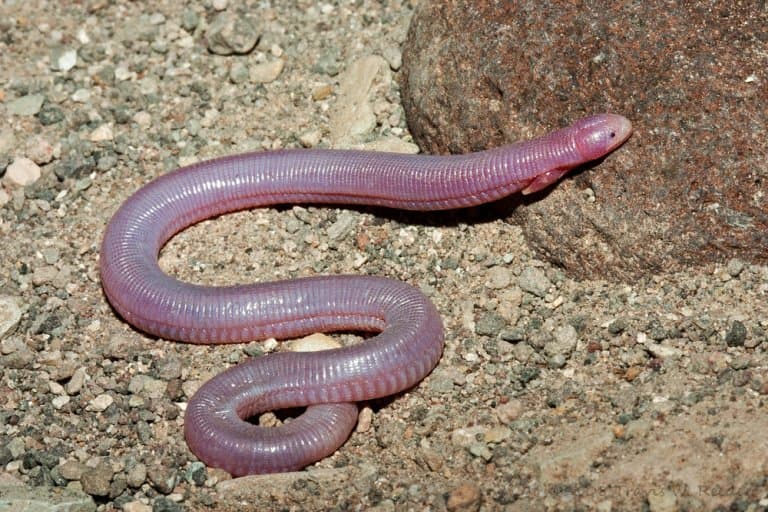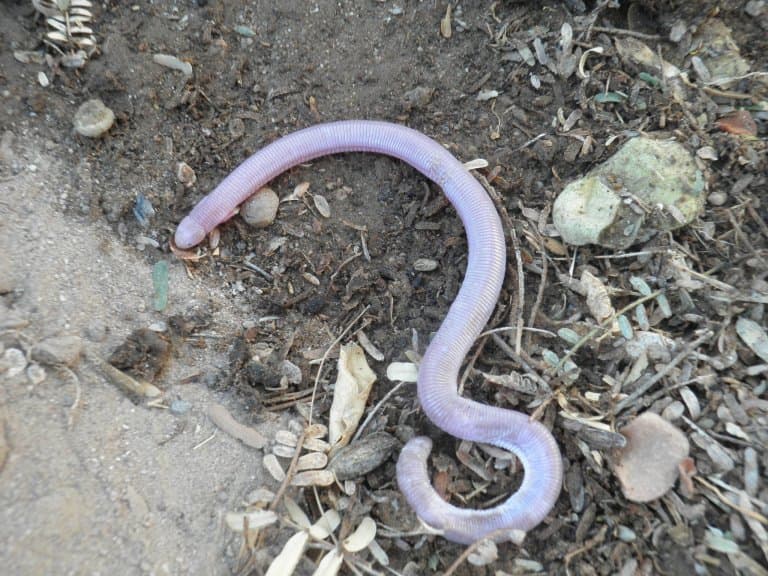Mexican Mole Lizard Profile
What would happen if you were to combine a lizard, a mole, a snake, and a worm? You’d probably end up with something that looks a lot like the Mexican Mole Lizard.
This elusive and unusual looking reptile from the Baja California Peninsula in Mexico has conjured up some curious folklore surrounding its behaviour and morphology that will have almost anyone shuddering in terror of what may be lurking in the bathroom…

Mexican Mole Lizard Facts Overview
| Habitat: | Shrubland and deserts |
| Location: | Baja California Peninsula, Mexico |
| Lifespan: | 1-2 years |
| Size: | Up to 24cm (9.4 Inches) |
| Weight: | 3.7 – 5.3 grams |
| Color: | Pink, turning pale with maturity |
| Diet: | Mostly ants, termites, and ground dwelling insects |
| Predators: | Coral Snakes |
| Top Speed: | 0.1km/h |
| No. of Species: |
3 |
| Conservation Status: |
Least Concern |
The Mexican Mole Lizard is a small, legless lizard that can reach around 9 inches long and has a light pink colouring which can turn white as it becomes older.
It is due to its subterranean lifestyle that it has become this colour, as it doesn’t possess the high levels of the colour boosting melanin which other animals need to protect their skin against sunlight.
They are rarely seen above ground, spending most of their time digging around searching for food with their tough, shovel-like heads and two small but strong forelimbs (much like those of a mole), which they also use to pull themselves along on the surface when slithering isn’t an option.
While these lizards mostly feed on ground-dwelling insects such as ants & termites, they are opportunistic predators that will exploit any food source that they can find, both underground and on the surface, providing they can get their mouth around it!
Due to its elusive nature, the Mexican Mole Lizard is an often-misunderstood creature. It is commonly mistaken for a snake, and due to its pink colouring and segmented looking body, can often be a mistaken for a worm.
It’s their resemblance to a snake, however, that often leads to them to being killed by humans out of fear. Yet there is another, more sinister fear that can be the cause of death by human hands…
Interesting Mexican Mole Lizard Facts
1. There’s a myth that they lurk in toilets, wriggling into an unassuming victim’s nether regions
While there are no recorded cases of the act, there is a local myth that the Mexican Mole Lizard will climb up into an unsuspecting bathroom-goer’s certain orifice.
This local myth has given the Mexican Mole Lizard a bad reputation that can sometimes be fatal should a particularly squeamish person find one minding its own business near a bathroom.

2. They are the only legless lizards with… legs
While they belong to a group of legless lizards called ‘amphisbaenians’, the three species of Mexican Mole Lizards have their very own family called ‘Bipedidae’, due to their two small forelimbs.
Biped means “an animal that uses two legs for walking”. They don’t have hind legs.1

3. Mexican Mole Lizards move like worms underground
The Mexican Mole Lizard has its scales arranged in rings around their body, allowing them to retract and extend their bodies to edge forward through the dirt, much like your average earthworm.
4. There are three species of Mexican Mole Lizard
All three species are endemic to the same region, with their defining characteristic being the number of toes on their forelimbs (three, four, and five).
They are commonly referred to as the three-toed worm lizard, four-toed worm lizard and five-toed worm lizard.2
5. Mexican Mole lizards live in their own self-constructed burrow systems
Even though they spend most of their lives underground, they only burrow to depths of around 15cm.
This shallow depth allows for the warmth of the sun to help the Mexican Mole Lizard maintain a warm core temperature.
6. They dig their own graves
Not intentionally, but their burrows are the perfect size for hungry Coral snakes to enter and dine on an unsuspecting Mexican Mole lizard from whichever end they happen to bump into each other.
7. They hear through their skin
To be able to dig more efficiently, the Mexican Mole Lizard has had to give up the luxury of having ears, but this hasn’t hindered its ability to hear anything.
Thankfully, it has evolved a system that can direct vibrations directly from the skin to the cochlea (the part of the inner ear that is involved in hearing).
8. The location of their burrow determines their thermoregulation
Since the Mexican Mole Lizard doesn’t have the melanin present in their skin to protect them from sunlight, they don’t bask in the sun to warm up like other reptiles.
Instead, they move their burrows to sunny or shaded locations to help maintain a regular body temperature.
9. They have poor eyesight
With poorly formed outer segments of their retinas, it is believed that the Mexican Mole Lizard can only detect light and dark environments, but not much in the way of image formation. 3

10. They are known locally as ‘Ajalote’
Not only do they have the reputation of lurking in the murky water awaiting their next victim, but they are mistakenly called ‘Ajalote’ by the locals.
This is the Spanish word for another small and pink creature that lurks in underwater lairs; the Axolotl.
11. The Mexican Mole Lizard is endemic to the Baja California Peninsula, Mexico
This means that they can’t be found anywhere else in the wild on planet Earth!
Mexican Mole Lizards have been found ranging from southwestern California State through western Baja Californian Sur, to the Isthmus of La Paz and the western Cape Region.

12. When it’s life or death, they choose self-amputation!
The ability to self-amputate their tails on demand gives the Mexican Mole lizard a chance to escape hungry predators through the art of distraction.
They can also use this tactic to block their burrows, stopping any predator in their tracks while the Mexican Mole Lizard makes a swift exit.
13. They only get one chance
As useful as it is to use their tails to distract predators, they lack the ability to grow them back, meaning they only get one chance to escape with this tactic!
14. You can see their rear legs… with X-ray vision
The Mexican Mole Lizard may have lost the need for its rear legs over the years, but the vestigial bones are still present within their bodies and are visible with the use of X-ray technology.
You may be familiar with a vestigial bone left in the human body; the Coccyx, aka. your tailbone. 4
15. The Mexican Mole Lizard was once hunted like a wild west outlaw
During a study in the 1980s to determine the distributional limits of the Mexican Mole Lizard, ‘wanted dead or alive’ posters were positioned in strategic locations to encourage locals to find the species and hand them in to the scientists with information on where they were caught.
Mexican Mole Lizard Fact-File Summary
Scientific Classification
| Kingdom: | Animalia |
| Phylum: | Chordata |
| Class: | Reptilia |
| Order: | Squamata |
| Family: | Bipedidae |
| Genus: | Bipes |
| Species Names: |
Bipes Biporus Bipes canaliculatus Bipes tri-dactylus |
Fact Sources & References
- Theodore Papenfuss (1982), “The Ecology and Systematics of the Amphisbaenian Genus Bipes“, Academia.edu.
- Mahrdt, C. R., K. R. Beaman, J. H. Valdez-Villavicencio, and T. J. Papenfuss, (2022), “Bipes biporus“, University of Texas.
- G. Craig Gundy (1977), “Photoreceptor degeneration in the eyes of an amphisbaenian in response to constant light or constant darkness“, Wiley Online Library.
- Carling C. Urben, Juan D. Daza, Cristhian Cadena, Patrick J. Lewis, Monte L. Thies (2014), “The Homology of the Pelvic Elements of Zygaspis quadrifrons (Squamata: Amphisbaenia)“, Bone Biology.
